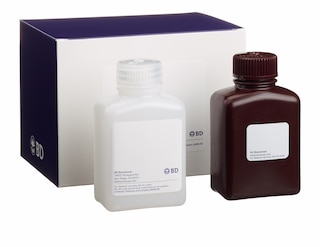Old Browser
This page has been recently translated and is available in French now.
Looks like you're visiting us from {countryName}.
Would you like to stay on the current country site or be switched to your country?


.png)

Expression of Notch1 in double-negative thymocytes. Fixed and permeabilized C57BL/6 thymocytes were stained with either PE Mouse anti-Mouse Notch1 or PE Mouse IgG1, κ Isotype Control MOPC-31C (Cat. No. 550617, open histogram). Cells were then stained with FITC Rat anti-Mouse CD4 (Cat. No. 553046/553047) and APC Rat anti-Mouse CD8a (Cat. No. 553035). For analysis of Notch1 expression, an electronic gate was set to include only the CD4-CD8a subpopulation. Flow cytometry was performed on a BD FACSCalibur™ Flow Cytometry System.
.png)

BD Pharmingen™ PE Mouse Anti-Mouse Notch1
.png)
Regulatory Status Legend
Any use of products other than the permitted use without the express written authorization of Becton, Dickinson and Company is strictly prohibited.
Preparation And Storage
Product Notices
- Since applications vary, each investigator should titrate the reagent to obtain optimal results.
- Please refer to www.bdbiosciences.com/us/s/resources for technical protocols.
- Caution: Sodium azide yields highly toxic hydrazoic acid under acidic conditions. Dilute azide compounds in running water before discarding to avoid accumulation of potentially explosive deposits in plumbing.
- For fluorochrome spectra and suitable instrument settings, please refer to our Multicolor Flow Cytometry web page at www.bdbiosciences.com/colors.
- An isotype control should be used at the same concentration as the antibody of interest.
Companion Products

.png?imwidth=320)
.png?imwidth=320)
.png?imwidth=320)
The Notch family of transmembrane receptors controls cell-fate "decisions" during the development of many organs in a wide variety of animal species. After binding its ligand, a Notch receptor is cleaved in its transmembrane domain, and the resulting intracellular domain dissociates from the membrane and translocates to the nucleus, where it is able to suppress the expression of lineage-specific genes by interacting with transcriptional repressors. The mN1A antibody reacts with the intracellular domain of mouse and human Notch1, but not with mouse Notch2, 3, or 4. In the mouse, Notch1 mRNA is expressed in mouse hematopoietic cells of the fetal liver and adult thymus and bone marrow. Using mAb mN1A, Notch1 is detected in CD4-CD8- (double-negative) and CD4-CD8+ thymocytes. Studies of Notch1-transgenic cells and Notch1-null mice indicate that the receptor is involved in the regulation of lymphopoiesis and myelopoiesis. The mN1A mAb does not cross-react with rat thymocytes. An alternative anti-mouse Notch1 monoclonal antibody, clone 22E5.5, specifically binds to an extracellular domain of mouse Notch1.

Development References (8)
-
Anderson AC, Robey EA, Huang YH. Notch signaling in lymphocyte development. Curr Opin Genet Dev. 2001; 11(5):554-560. (Biology). View Reference
-
Artavanis-Tsakonas S, Rand MD, Lake RJ. Notch signaling: cell fate control and signal integration in development.. Science. 1999; 284(5415):770-6. (Biology). View Reference
-
Huppert SS, Le A, Schroeter EH, et al. Embryonic lethality in mice homozygous for a processing-deficient allele of Notch1. Nature. 2000; 405(6789):966-970. (Immunogen). View Reference
-
Kawamata S, Du C, Li K, Lavau C. Notch1 perturbation of hemopoiesis involves non-cell- autonomous modifications. J Immunol. 2002; 168(4):1738-1745. (Biology). View Reference
-
Kojika S, Griffin JD. Notch receptors and hematopoiesis. Exp Hematol. 2001; 29(9):1041-1052. (Biology). View Reference
-
Milner LA, Bigas A, Kopan R, Brashem-Stein C, Bernstein ID, Martin DI. Inhibition of granulocytic differentiation by mNotch1. Proc Natl Acad Sci U S A. 1996; 93(23):13014-13019. (Biology). View Reference
-
Milner LA, Bigas A. Notch as a mediator of cell fate determination in hematopoiesis: evidence and speculation. Blood. 1999; 93(8):2431-2448. (Biology). View Reference
-
Walker L, Carlson A, Tan-Pertel HT, Weinmaster G, Gasson J. The notch receptor and its ligands are selectively expressed during hematopoietic development in the mouse. Stem Cells. 2001; 19(6):543-552. (Biology). View Reference
Please refer to Support Documents for Quality Certificates
Global - Refer to manufacturer's instructions for use and related User Manuals and Technical data sheets before using this products as described
Comparisons, where applicable, are made against older BD Technology, manual methods or are general performance claims. Comparisons are not made against non-BD technologies, unless otherwise noted.
For Research Use Only. Not for use in diagnostic or therapeutic procedures.
Report a Site Issue
This form is intended to help us improve our website experience. For other support, please visit our Contact Us page.